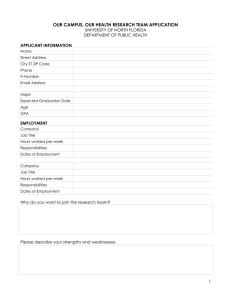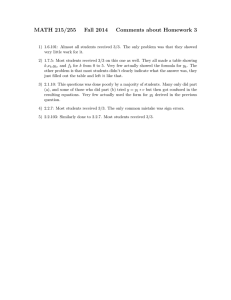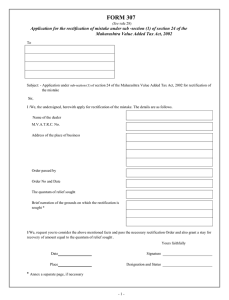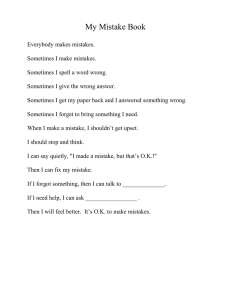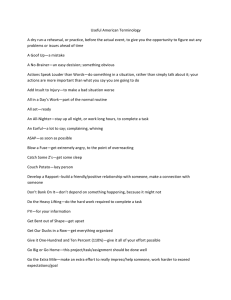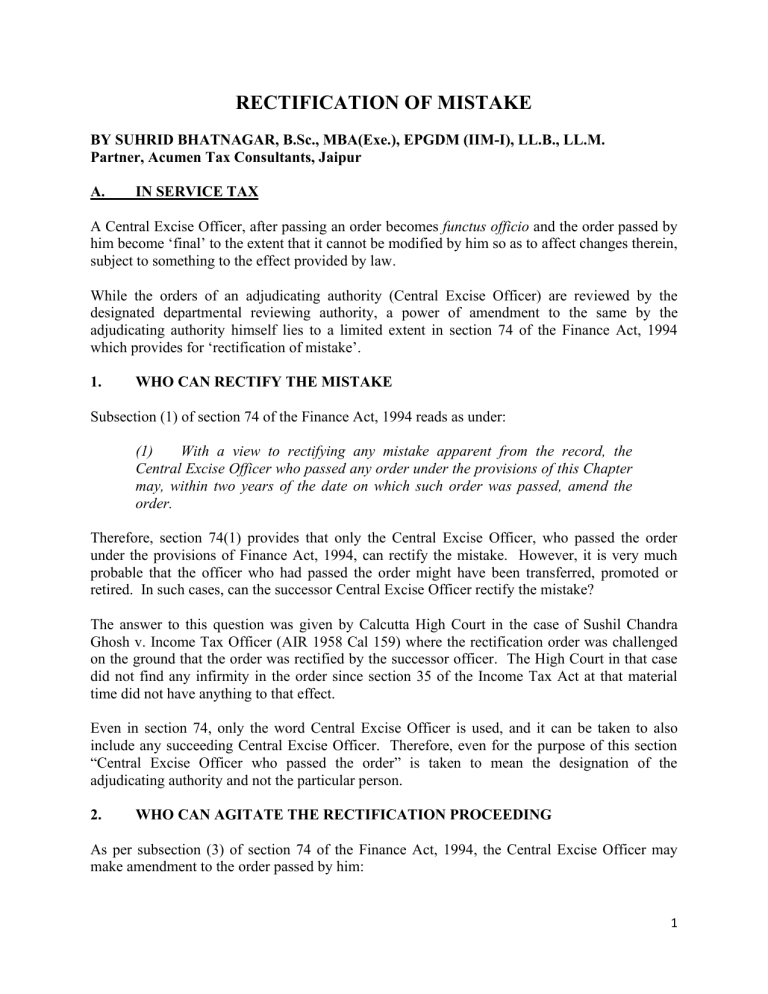
RECTIFICATION OF MISTAKE
BY SUHRID BHATNAGAR, B.Sc., MBA(Exe.), EPGDM (IIM-I), LL.B., LL.M.
Partner, Acumen Tax Consultants, Jaipur
A.
IN SERVICE TAX
A Central Excise Officer, after passing an order becomes functus officio and the order passed by
him become ‘final’ to the extent that it cannot be modified by him so as to affect changes therein,
subject to something to the effect provided by law.
While the orders of an adjudicating authority (Central Excise Officer) are reviewed by the
designated departmental reviewing authority, a power of amendment to the same by the
adjudicating authority himself lies to a limited extent in section 74 of the Finance Act, 1994
which provides for ‘rectification of mistake’.
1.
WHO CAN RECTIFY THE MISTAKE
Subsection (1) of section 74 of the Finance Act, 1994 reads as under:
(1)
With a view to rectifying any mistake apparent from the record, the
Central Excise Officer who passed any order under the provisions of this Chapter
may, within two years of the date on which such order was passed, amend the
order.
Therefore, section 74(1) provides that only the Central Excise Officer, who passed the order
under the provisions of Finance Act, 1994, can rectify the mistake. However, it is very much
probable that the officer who had passed the order might have been transferred, promoted or
retired. In such cases, can the successor Central Excise Officer rectify the mistake?
The answer to this question was given by Calcutta High Court in the case of Sushil Chandra
Ghosh v. Income Tax Officer (AIR 1958 Cal 159) where the rectification order was challenged
on the ground that the order was rectified by the successor officer. The High Court in that case
did not find any infirmity in the order since section 35 of the Income Tax Act at that material
time did not have anything to that effect.
Even in section 74, only the word Central Excise Officer is used, and it can be taken to also
include any succeeding Central Excise Officer. Therefore, even for the purpose of this section
“Central Excise Officer who passed the order” is taken to mean the designation of the
adjudicating authority and not the particular person.
2.
WHO CAN AGITATE THE RECTIFICATION PROCEEDING
As per subsection (3) of section 74 of the Finance Act, 1994, the Central Excise Officer may
make amendment to the order passed by him:
1
a) on his own motion i.e. by himself, or
b) if any mistake is brought to his notice by
i. the assessee, or
ii. Commissioner of Central Excise, or
iii. Commissioner of Central Excise (Appeals)
Therefore, in respect of an order passed by a Deputy / Assistant Commissioner or Additional /
Joint Commissioner, their reviewing as well as first appellate authorities are also empowered to
bring into notice the mistake so that the said Deputy / Assistant Commissioner or Additional /
Joint Commissioner can rectify the mistake under section 74(3). However, the section lacks in
the sense that it does not elaborately cover the cases where the order has been passed by the
Commissioner for which reviewing authority is the jurisdictional Chief Commissioner and
appellate authority is CESTAT.
3.
WHAT CAN BE RECTIFIED
As per subsection (1) of section 74 of the Finance Act, 1994, only a mistake apparent from the
record can be rectified by way of amending the order.
Further, as per subsection (2) of section 74 of the Finance Act, 1994, even if the matter has been
considered and decided in any proceeding by way of appeal or revision relating to the order
requiring the amendment, the Central Excise Officer passing such order may, notwithstanding
anything contained in any law for the time being in force, amend the order under sub-section (1)
in relation to any matter other than the matter which has been so considered and decided.
4.
WHAT IS ‘MISTAKE APPARENT FROM THE RECORD’
The phrase ‘mistake apparent from the record’ has not been defined in the Finance Act, 1994.
However, to find as to what is a ‘mistake apparent from the record’, we have to look at various
case laws, most of which relate to Income Tax.
In TS Balaram, ITO v. Volkart Brothers, Bombay {(1971) 2 SCC 526} it has been held by the
Supreme Court that “a mistake apparent on the record must be an obvious and patent mistake and
not something which can be established by a long drawn process of reasoning on points on which
there may conceivably be two opinions.”
In Gammon India Limited v. Commissioner of Income-Tax {1995 214 ITR 50 Bom} ‘mistake
apparent from the record’ has been discussed in elaborate details and while relying upon the
aforesaid case of TS Balaram, ITO, it has been held by the Bombay High Court that
“Besides, it must be a mistake which is patent on the face of the record and does not call
for detailed investigation of the facts or require an elaborate argument to establish it. It
does not cover any mistake which may be discovered by a complicated process of
investigation, argument or proof. The mistake sought to be rectified must be manifest and
self-evident on the face of the record. It must be one which is apparent and not lurking,
which is visible and not dormant, which can be seen and not hidden. It cannot be
2
demonstrated to exist by relying upon materials outside the record. A decision on a
debatable point of law or failure to apply the law to a set of facts which remain to be
investigated cannot be corrected by way of rectification. The legal position is thus now
settled that a mistake which is not obvious, patent and self-evident and mistake on which
conceivably there can be two opinions cannot be rectified by way of rectification of
mistake under section 154 of the Act. In other words, in the garb of exercise of the power
of rectification under section 154 of the Act, the income-tax authorities cannot revise or
review their order generally or reconsider the conclusions arrived therein on the facts
before them at that time on the basis of new facts brought on record by the party seeking
rectification or coming into possession otherwise, because the jurisdiction under section
154 is confined to rectification of mistakes apparent from the record.”
It is also worthwhile to note here that the term ‘record’ has not been defined in the Finance Act,
1994. Only the term ‘specified records’ is provided in the explanation to Section 73(4A) of the
Finance Act, 1994 (which is proposed to be omitted by clause 110 of the Finance Bill, 2015)
which is not relevant here. In the above case of Gammon India Limited, the High Court also
held that:
“‘Record’ in such a case would mean record of the case comprising the entire
proceedings including documents and materials produced by the parties and taken on
record by the authorities which were available at the time of passing of the order which
is the subject-matter of proceedings for rectification. They cannot go beyond the records
and look into fresh evidence or materials which were not on record at the time the order
sought to be rectified was passed.”
In Batuk K. Vyas v. Surat Municipality {ILR 1953 Bom 191 : AIR 1953 Bom 133}, it was held
that no error can be said to be apparent on the face of the record if it is not manifest or selfevident and requires an examination or argument to establish it.
In the leading case of Hari Vishnu Kamath v. Syed Ahmad Ishaque {(1955) 1 SCR 1104}, the
Constitution Bench of this Court quoted the observations of Chagla, C.J. in aforesaid Batuk K.
Vyas case and admitted that though the said test might apply in majority of cases satisfactorily,
however, the court proceeded to comment that there might be cases in which it might not work
inasmuch as an error of law might be considered by one Judge as apparent, patent and selfevident, but might not be so considered by another Judge. The Court, therefore, concluded that
an error apparent on the face of the record cannot be defined exhaustively there being an element
of indefiniteness inherent in its very nature and must be left to be determined judicially on the
facts of each case.
In CIT v. Harnand Roy Shrikishan A. Kodia {(1966) 61 ITR 50 (MP)}, it was held that a mistake
will not be a mistake apparent from record if it required extraneous evidence to be brought in for
rectifying that mistake. Rather, a mistake apparent from record should be shown to be a mistake
that can be gathered from the records of the case.
In CTO v. Sri Venkateswara Oil Mills {(1974) 3 SCC 5: (1973) 32 STC 660 (SC)}, it was held
that a decision on a debatable point of law is not a mistake apparent from record. Thus a
3
“mistake apparent on record” must not be something which can be established by a long drawn
process of reasoning on points on which there may be conceivably two opinions.
In N. Rajamoni Amma v. Dy. CIT {(1990) 86 CTR 12 (Ker)}, it was held that a decision on the
debatable point of law or fact or failure to apply the law to a set of facts which remain to be
investigated cannot be corrected by rectification. However, a glaring and obvious mistake of law
not requiring long drawn process of reasoning can be rectified as a mistake apparent from record
as held in M.K. Venketachalam v. Bombay Dyeing & Mfg. Co. Ltd. {AIR 1958 SC 875: (1958)
34 ITR 143 (SC)}. In this case certain assessments became erroneous because Parliament
enacted an amendment with retrospective effect. These assessments were taken to be suffering
from a mistake apparent from the record.
In CIT v. Kesri Metal Private Limited {AIR 1999 SC 3801, 1999 237 ITR 165 SC, JT 1999 (3)
SC 45, (1999) 9 SCC 165}, it has been held by the Supreme Court that “a look at the record must
show there has been an error, and that error may be rectified.”
In ACIT v. Saurashtra Kutch Stock Exchange Ltd. in Civil Appeal No. 1171 of 2004, the
Supreme Court on September 15, 2008 opined that non-consideration of a decision of
Jurisdictional Court or of the Supreme Court can be said to be a "mistake apparent from the
record" which could be rectified.
In Deva Metal Powders (P) Limited v. Commissioner, Trade Tax, Uttar Pradesh, reported in
2008 (2) S.C.C.439, the Supreme Court held that a `rectifiable mistake' must exist and the same
must be apparent from the record. It must be a patent mistake, which is obvious and whose
discovery is not dependant on elaborate arguments.
In Commissioner of Central Excise, Calcutta v. A.S.C.U. Limited [2003 (151) E.L.T. 481 (SC)],
it was held that a `rectifiable mistake' is a mistake which is obvious and not something which has
to be established by a long drawn process of reasoning or where two opinions are possible.
Decision on debatable point of law cannot be treated as "mistake apparent from the record".
In Onkar Travels (P) Ltd. v. CCE, Jalandhar [2006 (3) S.T.R. 164 (Tri. - Del.)], it has been held
that when assessment under section 71 of Finance Act, 1994 is done finally, it cannot be said that
there was an error and appellant did not produce relevant records. [Maintained in 2008 (10) STR
237 (Punjab & Haryana High Court)]
In Force Seven Security v. CCE (2007) 8 STT 10 (CESTAT) it has been held that rectification of
order pertains to certain clerical or arithmetic mistakes and not of revising the order.
In Gujarat Security Services v. CST(2008) 13 STT 166 (CESTAT SMB), it has been held that
mistake that can be rectified may be arithmetical, typographical or calculation mistake. By no
stretch of imagination, it can be extended to an interpretation of provision of law.
5.
LIMITATION:
4
As per subsection (1) of section 74 of the Finance Act, 1994, for rectification of mistake apparent
from the record, the Central Excise Officer may amend the order within two years of the date on
which such order was originally passed. The section does not provide for condonation of delay,
and therefore it has to be within two years from the date of passing the order that such an order
be amended for rectification of mistake apparent from the record. Therefore, such mistake has to
be brought to the notice of the Central Excise Officer well in time, so that if so necessitates, he is
allowed time to give notice and a reasonable opportunity to be heard to the assessee.
6.
MANNER OF PASSING THE AMENDING ORDER
6.1
The amending order by the Central Excise Officer may have an impact either way, i.e. it
can enhance the liability of the assessee or reduce the refund to the assessee, or it can reduce the
liability of the assessee or increase the refund to the assessee.
6.2
In terms of subsection (4) of section 74, if the amendment has effect of enhancing the
liability of the assessee or reducing a refund, the order shall be made only after giving a notice to
the assessee of his intention so to do and after allowing the assessee a reasonable opportunity of
being heard. In nutshell, if the effect of the order is adverse to the interests of the assessee, the
principle of natural justice must be followed. In terms of subsection (5), for making the
amendment to the original order, the Central Excise Officer shall pass an order in writing
wherein, in terms of subsection (7), the sum payable by the assessee shall be specified.
The section is not explicit enough to speak that in case of increase / decrease in liabilities and
decrease / increase in refund, what shall happen to the penalties already imposed. Subsection (7)
only speaks that “and the provisions of this Chapter shall apply accordingly”, which implies that
along with enhancing the liability, the applicable penalties which depend upon the quantum of
liability may also be enhanced accordingly, wherever applicable.
In Force Seven Security v. CCE (2007) 8 STT 350 (CESTAT SMB), it was held that rectification
proceedings cannot be used to enhance penalty already imposed. Proper course is for
Commissioner to use revisionary powers. However, this case pertains to the period when the
Commissioner used to issue Orders-in-Revision in service tax cases.
6.3
In terms of subsection (4) of section 74, if the amendment has the effect of reducing the
liability of the assessee or increasing the refund, the Central Excise Officer shall make any
refund which may be due to such assessee.
There is no doubt here that such refund shall be consequential in nature. The important question
here is as to what shall be the relevant date from which limitation for filing the refund shall
apply. None of the categories given in Explanation (B) to Section 11B of Central Excise Act,
1944 defining the ‘relevant date’ pertains to the amending orders passed by the Central Excise
Officer for rectification of mistake under section 74 of the Finance Act, 1994. The closest entry
which is found is clause (ec) to the said explanation which pertains to the cases where the duty
becomes refundable as a consequence of judgment, decree, order or direction of appellate
authority, Appellate Tribunal or any court and the relevant date in such cases is the date of such
judgment, decree, order or direction. However, it does not mention the orders for rectification of
mistake passed by the original adjudicating authorities under section 74 of the Finance Act,
5
1994. The last entry is clause (f) which speaks ‘in any other case, the date of payment of duty’,
and therefore if this entry is taken into account, the refunds are more than likely to be hit by
limitation.
7.
PROBABLE MISUSE OF THIS PROVISION
In cases where limitation for appeal has expired, the assessee may take recourse to this provision
by contending some mistake in the order. However, it is to be carefully seen by the Central
Excise Officer that such mistake should be apparent from the record of the proceedings itself,
and the attempt of the assessee to introduce any new or extraneous document / evidence may be
turned down.
In the case of Onkar Travels (P) Ltd. v. CCE, Jalandhar reported at 2006 (3) S.T.R. 164 (Tri. Del.), it has been held that if an appeal is not filed within time under Section 85 ibid, opportunity
to re-open assessment cannot be read into provisions of Section 74 ibid. [Maintained in 2008
(10) STR 237 (Punjab & Haryana High Court)]
In KP Dinakaran v. CCE (2007) 9 STT 277 (CESTAT), it has been held that in guise of
rectification of mistake, entire complexion of order cannot be altered under section 74. Proper
course of action will be revision by Commissioner under section 84.
In Girnar Impex v. State of Punjab (2009) 20 STT 477 (P&H HC DB) it has been held that fresh
issue cannot be taken in rectification proceedings.
8.
OTHER ISSUES
8.1
There is no restriction in section 74 upon the number of amending orders that can be
passed by the Central Excise Officer. Therefore, the Central Excise Officer may issue more than
one amending orders. Again, such mistakes should be apparent from the record and the
amending orders must be passed within the limitation of two years from the date of the original
order.
B.
IN CENTRAL EXCISE
There is no provision for rectification of mistake by the Central Excise Officer in Central Excise
Act, 1944.
C.
BY COMMISSIONER (APPEALS)
There is no provision for rectification of mistake by the Commissioner (Appeals) in Central
Excise under Central Excise Act, 1944 or in Service Tax under Finance Act, 1994.
D.
BY APPELLATE TRIBUNAL
1.
As per section 35B(7) of the Central Excise Act, 1944, every application made before the
Appellate Tribunal for rectification of mistake shall be accompanied by a fee of five hundred
6
rupees, provide that no such fee shall be payable in the case of an application filed “by or on
behalf of the Commissioner of Central Excise under this sub-section”.
2.
As per section 86(6A) of the Finance Act, 1994, every application made before the
Appellate Tribunal for rectification of mistake shall be accompanied by a fee of five hundred
rupees, provide that no such fee shall be payable in the case of an application filed “by the
Commissioner of Central Excise or Assistant Commissioner of Central Excise or Deputy
Commissioner of Central Excise, as the case may be under this sub-section.”
3.
In terms of section 86(7) of the Finance Act, 1994, the in respect of hearing the appeals
and making orders under the section 86, the Appellate Tribunal shall exercise the same powers
and follow the same procedure as given in Central Excise Act, 1944. Such powers and
procedures are given in Section 35C of the Central Excise Act, 1944.
4.
Further, section 35C(2) of Central Excise Act, 1944 provides that:
“(2) The Appellate Tribunal may, at any time within six months from the date
of the order, with a view to rectifying any mistake apparent from the record,
amend any order passed by it under sub-section (1) and shall make such
amendments if the mistake is brought to its notice by the Commissioner of
Central Excise or the other party to the appeal:
Provided that an amendment which has the effect of enhancing an
assessment or reducing a refund or otherwise increasing the liability of the
other party, shall not be made under this sub-section, unless the Appellate
Tribunal has given notice to him of its intention to do so and has allowed him
a reasonable opportunity of being heard.”
Therefore, it emanates from the above that limitation for rectifying the mistake apparent from the
record is six months from the order of the Tribunal. Such mistake may be brought to the notice
of the Tribunal by the Commissioner of Central Excise or the other party to the appeal. Also, an
amendment which has the effect of enhancing an assessment or reducing a refund or otherwise
increasing the liability of the other party can be made only after giving a notice to the assessee
and also allowing him a reasonable opportunity of being heard.
Further, the meaning of the phrase ‘‘mistake apparent from the record’ shall carry the same
meaning as decided by appellate tribunals and courts as discussed in detail above.
5.
In the case of Sirpur Paper Mills v. CCE [1986 (24) E.L.T. 49], Saurashtra Cement and
Chemical Industries [1987 (29) E.L.T. 87], M.C. Desai v. Collector [1991 (56) E.L.T. 425] and
National Rayon Corporation Ltd. [1993 (67) E.L.T. 186], the Tribunal has held that rectification
of an earlier order of the Tribunal cannot be made on the basis of a later order interpreting
relevant provisions differently.
7
In Gujarat State Fertilizers and Chemicals Ltd. v. Commr. Of C. Ex., Vadodara [2000 (122) ELT
282 (Tri LB)], again the issue referred to the Larger Bench was as to whether a subsequent
decision of the Tribunal or a High Court or the Supreme Court can form the basis for
rectification of mistake in terms of Section 35C(2) of the Central Excise Act, 1944. While the
counsel of the appellants had contended that a subsequent decision of the Supreme Court is a
ground for recalling the Tribunal's final order for rectification of mistake apparent from record,
the Larger Bench, relying on the above said case laws, held that a subsequent decision of the
Tribunal cannot form the basis of rectification of a mistake in terms of the section 35C(2) of the
Central Excise Act, 1944.
However, the above case was overruled in the case of Hindustan Lever Ltd. v. Commissioner of
C.Ex., Mumbai-I [2008 (10) STR 91 (Tribunal LB)] and it was held that:
“Rectification of mistake - When Supreme Court pronounces on true position of law, any
decision rendered by any other authority contrary to that, is required to be regarded as
an error which is apparent on record and rectification of such an error within period
permissible under law and in accordance with provisions of statute was required to be
effected, as held by Madras High Court in case of V. Guard Industries Ltd. - Section
35C(2) of Central Excise Act, 1944.”
In the same case, it was also held that:
“Rectification of mistake - When a decision rendered by Apex Court is not considered,
non-consideration of such binding precedent would constitute an error apparent on face
of record by applicability of doctrine of per incuriam - Though in context of decisions of
Apex Court and jurisdictional High Courts which are rendered after order of Tribunal,
the doctrine of per incuriam cannot be invoked, yet these would be error apparent from
record of such order on reasoning that superior court declared law as it always was and
question whether there was error apparent from record of order, would still arise Section 35C(2) of Central Excise Act, 1944.”
6.
As for limitation of six months for filing application for rectification of mistake in
CESTAT, in Commissioner of Central Excise, Pune-III v. GE Medical Systems [2013 (29)
S.T.R. 327 (Kar.)] following has been held:
“Appeal to High Court - Scope of - Finding of CESTAT that ROM application was filed
beyond six months period prescribed in Section 35C(2) of Central Excise Act, 1944 HELD : Even if it is question of law, there being no error in it, appeal to High Court is
not maintainable against it - It is more so when law in that respect had already been
declared by Supreme Court - Section 35G of Central Excise Act, 1944 as applicable to
Service Tax vide Section 83 of Finance Act, 1994.”
8
“Rectification of mistake - Limitation - It cannot go beyond prescribed period of six
months from date of order - On facts, ROM application filed beyond six months of
CESTAT order, but within that period from date of its receipt - Rejection of ROM
application by CESTAT, upheld - Section 35C(2) of Central Excise Act, 1944.”
Therefore, looking at the above provisions of law, it emerges that power of ‘rectification of
mistake’ lies with the Central Excise Officer is service tax cases only and with the Appellate
Tribunal in respect of service tax as well as central excise cases. The power is an important tool
to fix any errors which are apparent from the record.
(The views expressed in the article are strictly personal)
9

